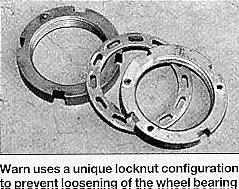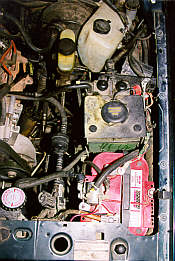Mazda
5 Speed Manual Transmission
Click for
Online Discussion of this tip
Many Explorer/Navajo owners
have went with synthetic transmission fluid hoping to extend the life of
the transmission. I use Mobil 1 Synthetic fluid. Synthetic
fluid handles high temperatures and pressures better then conventional
fluids.
Another preventive maintenance
tip is to replace the rubber plugs in the shift rail bores with steel freeze
plugs. The rubber plugs have a tendency to dry up and leak, and/or fall
out. The plugs are located in the transmission top cover and face towards
the rear of the truck. The part numbers for the metal plugs are: Dana #219-3052
or Dorman #555-108, you will need 3 plugs to do the job.
The hydraulic clutch, slave
cylinder/throwout bearing is another item you should pay close attention
to. After time, the slave cylinder fails to release the clutch completely.
If you are having trouble shifting into 1st and reverse while stationary
or if your truck creeps forward with the clutch pedal depressed the slave
cylinder/throwout bearing is probably at fault. Unfortunately there is
no easy fix here as the transmission must be removed to replace the combination
slave cylinder and throwout bearing.
Wheel
Bearings
I have found that when running
large tires on the Explorer a severe jolt to the wheel can cause the outer
spindle locknut to come loose, causing excessive play in the wheel bearing
(loss of preload).
In the stock configuration,
the inner spindle nut has a pin which engages a keyed washer. The keyed
washer keeps the inner nut from turning but there is nothing to keep the
outer nut from breaking loose except the torque that is applied to it.
Warn now has a solution to
this problem. Warn part #37207* (conversion kit) replaces the stock keyed
washer with a new washer which incorporates slots instead of holes for
locking purposes. The new outer locknut has been drilled for three small
allen screws. These screws when tightened will engage one or more of the
slots in the washer. Combined with the stock pinned inner locknut this
makes for a nearly bullet proof set up. I have yet to experience a problem
with the new locknuts.
*Warn has discontinued part #37207. The only way to get the required
parts is to make them yourself. Another possibility for
improving the wheel bearing nut lock nuts is located here: SPINDLE
NUT UPGRADE

High
Performance Computer Chips
There has been a lot of
discussion as to which chip is best for the Explorer. I only have experience
with the Hypertech chip.
After installing the Hypertech
module in the computers service port bay I noticed that the engine would
pull harder in the mid-range and top-end. The engine is now able to turn
at least 500rpm more than stock (stock 4200rpm, modified 4700rpm) as indicated
by the factory tachometer. This is definitely a plus when you need the
extra top end. The Hyper tech chip also disables the stock speed limiter
which kicks in at about 95 or so. I haven't noticed any change in fuel
economy at all. The biggest improvement for my vehicle, was that it eliminated
the pinging I was getting at freeway speeds on 105deg and hotter days in
Phoenix. The pinging has been completely eliminated and I still run regular
unleaded.
Radio
Frequency Interference
Anyone
using a ham radio or C.B. in their Explorer has most likely heard the effects
of RFI. The interference sounds like a high ambient noise level and the receiver
possibly shows many S-units of signal strength even when there
is no one transmitting. The in-tank mounted electric fuel pump is the source
of this problem.
Fortunately
Ford has a fix for this problem which is covered under the original warranty.
If the truck is out of warranty you can get the parts and do the job yourself
or have it performed at a shop. The Service Bulletin that covers this problem
is # 9117-5. The part you need is a Filter Kit, Ford Part # E7PZ9B357A.
Although
the addition of the filter did cure about 90% of the problem some interference
is still noticeable on a few of the Ham Radio bands. Even so, it sure sounds
much better then before the fix.
Additional info from Pat Freeman:
I was having fuel pump noise and saw the TSB and part number listed in the tech
tips section. I gave these to my dealer and he let me know that these were for
vehicles up to 1999. There is some updated information that we all might benefit
from
I have a 2001 Sport Trac and TSB # 01-07-03 is for installation of a noise
suppressor in the fuel tank, Part # F1PZ 18B925 A.
Adding
an Auxiliary Battery
Where
in the heck did you find the room to mount a second battery?
I
removed the stock windshield washer/coolant tank and cut the  tank
apart between the two separate compartments. I discarded the washer fluid
tank and kept the coolant tank. I then mounted the coolant tank to the
Explorers fuel tank vent, which has two round plastic caps on top of it.
The coolant tank is now attached to the vent housing with a piece of perforated
metal strapping. tank
apart between the two separate compartments. I discarded the washer fluid
tank and kept the coolant tank. I then mounted the coolant tank to the
Explorers fuel tank vent, which has two round plastic caps on top of it.
The coolant tank is now attached to the vent housing with a piece of perforated
metal strapping.
With
the coolant tank relocated, there is plenty of room for a second
Optima battery. I mounted a steel battery tray to the inner fender using
a block of wood as a spacer to hold the tray level. The wood is bolted
to the metal ledge and the tray is attached to the wood block.
I replaced
the stock washer fluid tank with the smallest tank I could find at a junkyard
(I think it was out of an old Dodge). I mounted it next to the master cylinder,
towards the fender.
The
second battery is charged using a continuous duty solenoid as the isolation
device. With the three position switch mounted on the dash I can charge
both batteries, isolate the auxiliary battery, or jump start myself.
Fix
for a Missing Engine
Posted
by: Jack Lobdell
Many
Explorer owners have experienced "bogging" or "missing" or just unsteady
performance in their 4.0 engine and have been frustrated by lots of expensive
"non-fixes". After riding on a plane next to a manufacturing trainer
from a company that builds OEM replacement auto electrical components for
places like AutoZone and CarQuest, I tried his tip. He says that Ford have
these problems more than other makes and the 4.0 engine seems to be more
susceptible to the problem than other Ford engines.
It
seems that a "missing" engine culprit is actually the computer's sensor
inside the Mass Air Flow Sensor (MAF). It eventually just gets a little
dirty or builds up its own patina in the filament wires. A dirty or slightly
patinaed filament will send the wrong air reading to the computer, saying
it is getting more air than it really is and the computer will tell the
EFI to send in the wrong mix of fuel, thus, the bogging. The patina seems
to form faster if you live in a damp climate. I don't so here in New Mexico
mine went 82K before it developed a small "flat idle spot"
it would run
just fine but the idle began to drop every few revs from 700 to 500. No
big deal.
If
you have had bogging or missing or idle spots, about every 25K miles plan
on this quick cleaning job:
When
your engine is cool, remove the wiring clip from the side of the black
plastic sensor part of the MAF aluminum body. To remove the MAF interior
sensor wire, you will need a Security Star (Size T15 or T20) screwdriver
or screwdriver bit for a power screwdriver.
Remove the two security star-head screws and carefully remove the sensor.
You will see the two sensor filaments
they look almost like the filaments
on a light bulb. Carefully spray the filaments with an O2 safe carburetor cleaner, such as Gumout. Let it dry thoroughly. I help mine along with
a careful blast or two of canned dry air. While it is drying carefully
wipe the aluminum mount surface of the MAF body if there is any dust there,
but be careful not to get
dust in the mount hole. When the sensor is dry, replace the sensor back
in the MAF body and secure with the security star-head screws. These don't
need to be torqued down, just simply hand tight. Replace the wiring clip.
Then start up your engine. You should have solved any bogging or missing
problems. My flat idle spot is ancient history.
EXPLORER HOME | MORE
EXPLORERS
EXPLORERFORUM MESSAGE BOARD
Copyright 2008 Rick Horwitz Photography
|

